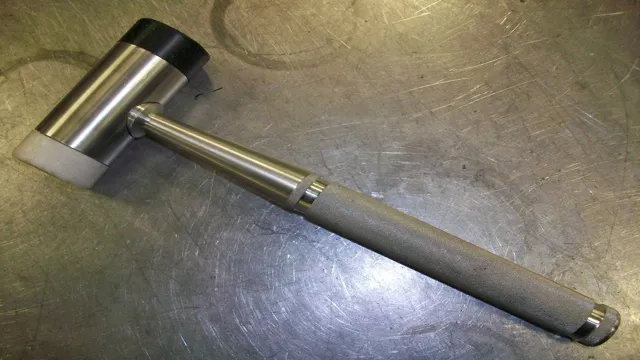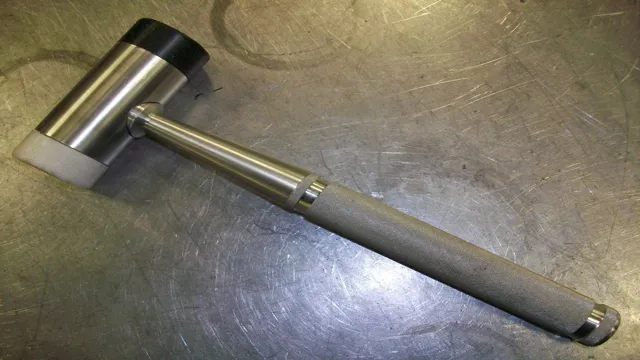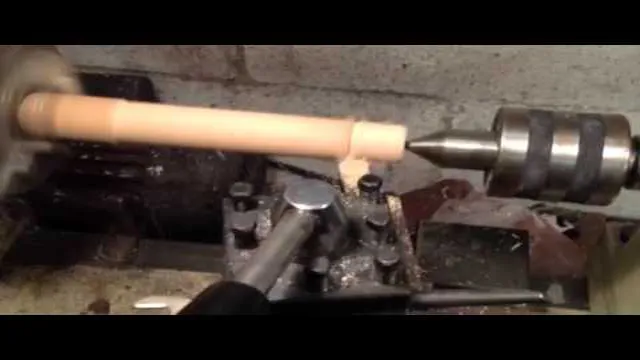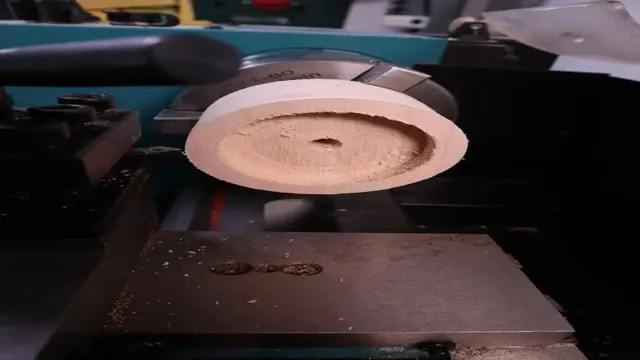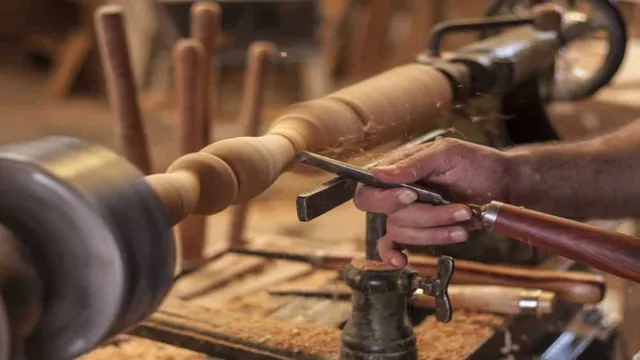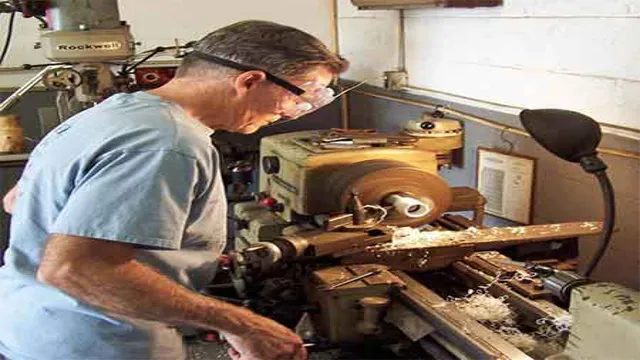How to Use a Metal Lathe for Beginners: A Comprehensive Guide to Getting Started
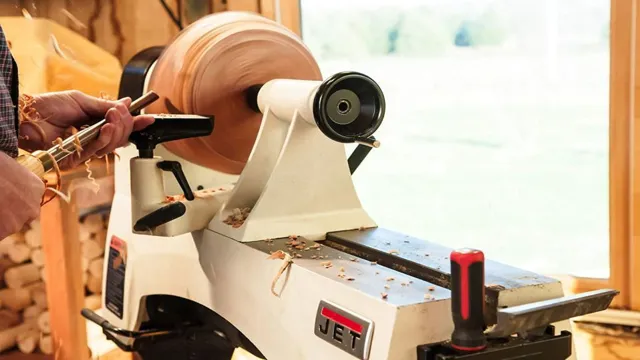
Welcome to the world of metalworking! If you’re reading this, chances are you’re either a beginner in metal lathing or you’re interested in learning more about it. Either way, you’re in the right place! Using a metal lathe might seem daunting at first, but once you understand the basics, you’ll soon discover that it’s a satisfying and rewarding craft. A metal lathe is a machine that is used to shape and cut metal pieces into various forms.
It’s a must-have tool for anyone looking to create custom metal parts, tools, or even artistic pieces. However, for beginners, operating a metal lathe can be overwhelming. The thought of spinning a chunk of metal at high speeds and shaping it with sharp tools can seem daunting.
But with practice and proper guidance, anyone can master the craft of metal lathing. This blog will be your ultimate guide to getting started with metal lathe for beginners. We’ll cover the basics of metalworking, safety measures, and the various components of a metal lathe.
We’ll also give you tips on how to choose the right lathe for your needs, and teach you essential techniques such as facing, threading, and turning. Furthermore, we’ll provide you with expert advice on how to maintain and sharpen your lathe tools, and give you some exciting project ideas to kickstart your metalworking journey. So, whether you’re interested in creating metal parts for your business, or you’re just looking for a new hobby, this blog will be your go-to resource for learning all the ins and outs of metal lathing.
By the end of it, you’ll have the confidence and skills required to use a metal lathe safely and efficiently. Get ready to embark on an exciting new journey. Let’s get started!
What is a Metal Lathe?
If you’re a beginner interested in metalworking, you may be wondering what a metal lathe is and how to use it. Simply put, a metal lathe is a machine tool used for shaping metal. It works by rotating a piece of metal and cutting it with a tool to create a desired shape.
To use a metal lathe, you’ll need to have a basic understanding of the various parts and functions of the machine. You will also need to know how to operate the controls and use the cutting tools. Safety is of utmost importance, so be sure to read and understand the user manual before operating the machine.
With practice and patience, you can become a pro at using a metal lathe and create some amazing metalwork projects. So, if you are up for the challenge, grab a metal lathe and start exploring the world of metalworking today!
Definition of a Metal Lathe
A metal lathe, also known as an engine lathe, is a versatile tool primarily used to cut, shape, or bore metal into a wide range of symmetrical forms and complex contours. It works by rotating the metal workpiece against a fixed cutting tool that removes material from the surface. The lathe machine can be operated manually or with computer numerical control (CNC) technology.
The CNC-controlled metal lathe has revolutionized the manufacturing industry, allowing for precision cuts and mass production with high accuracy and consistent quality. Metal lathes come in various sizes, from small benchtop lathes for hobbyists and DIY enthusiasts to large industrial lathes used in heavy-duty metalworking operations. These tools are crucial in industries such as aerospace, automotive, and construction, where metal components play a vital role in the finished product.
Overall, a metal lathe is an essential tool for any metalworker looking to shape and manipulate metal materials with precision and accuracy.

Types of Metal Lathes
A metal lathe is a machine tool that rotates a workpiece on its axis and uses cutting tools to remove unwanted material. These machines come in a variety of sizes and shapes, designed for specific types of metalworking tasks. The most common types of metal lathes include engine lathes, turret lathes, and duplicating lathes.
Engine lathes are the most versatile type and can handle a wide range of workpieces, from small to large. Turret lathes are mainly used for high-volume production of small, precise parts. Duplicating lathes are designed to create identical copies of a single piece, making them ideal for mass production.
Overall, metal lathes are essential tools for any metalworking project, providing precise cutting and shaping capabilities that can’t be achieved by hand alone.
Safety Precautions
If you’re new to using a metal lathe, it’s important to take safety precautions to avoid accidents. First, always wear appropriate gear, including safety glasses, gloves, and a face mask. Before beginning any project, make sure the lathe is properly set up and all tools are in good condition.
Ensure that the workpiece is properly clamped and secured before turning on the lathe. Keep your hands away from the rotating piece and don’t wear loose clothing that could get caught. When using cutting tools, keep them sharp and never reach across the lathe while it’s still running.
Always turn off the lathe and wait for it to come to a complete stop before making any adjustments or measurements. By following these basic safety guidelines, you’ll lower the risk of any accidents and ensure a successful metalworking experience.
Personal Protective Equipment (PPE)
Personal Protective Equipment (PPE) When it comes to working in hazardous environments, ensuring safety precautions must be a top priority. Wearing Personal Protective Equipment (PPE) is vital to protect oneself from potential harm. PPE comprises a range of safety gear such as helmets, gloves, goggles, masks, and shoes to prevent any harm to the head, hands, eyes, face, and feet.
Each piece of equipment is designed to shield workers from different hazards present in their working situation. For example, using earplugs will prevent hearing damage caused by loud noises, while respirators are vital for protecting workers from inhaling harmful chemicals or dust. It’s essential to understand the different types of PPE available and how they function correctly to ensure proper protection.
Always make sure to use correct and well-maintained safety gear to ensure complete protection in your workplace.
Machine Safety
When it comes to machines, safety should always be a top priority. Proper safety precautions can make the difference between a safe and efficient workplace and one that’s riddled with accidents and injuries. Some basic safety precautions include wearing protective gear, such as helmets, gloves, and goggles, to prevent injuries from flying debris, chemicals, and other hazards.
Regular inspections and maintenance of machines can also help prevent accidents. It’s important to keep machines in good working condition and address any malfunctions or wear and tear promptly. In addition, workers should be properly trained and educated on how to use machines safely, and any safety guidelines should be clearly communicated to all team members.
By taking these safety precautions seriously, we can create a safer and more productive work environment.
Proper Tool Selection and Handling
When it comes to working with tools, safety should be your top priority. One of the most crucial steps you can take towards ensuring your safety is proper tool selection and handling. The type of tools you use will depend on the task at hand.
Make sure to select the right tool for the job. Similarly, you should also make sure that the tools you’re using are in proper working condition. Inspect them before use and always follow manufacturer’s instructions for use and maintenance.
Take care when handling sharp or pointed tools such as knives, saws, or chisels. Always use safety gloves, eyewear, and other protective gear as needed. Always keep the work area free of clutter and distractions and use proper storage for your tools when not in use.
By taking these precautions, you can reduce your risk of injury and ensure a safe and effective work environment. Remember, safety is always first and foremost!
Preparing the Metal Lathe
If you’re new to using a metal lathe, it’s important to properly prepare the machine before you start working. First, make sure the lathe is clean and free of any debris or dust that may interfere with the accuracy of your work. Check the condition of the gears and belts and make sure they are properly adjusted and lubricated.
Next, select the appropriate cutting tool for your project. Use a tool that’s sharp and clean to ensure clean and precise cuts. Lastly, set the lathe’s speed to match the material you’ll be working with.
You can refer to the machine’s manual or consult with a professional for guidance. By following these simple steps, you’ll be well on your way to using a metal lathe like a pro in no time!
Machine Inspection
Preparing a metal lathe for machine inspection involves several crucial steps. Firstly, the lathe’s exterior should be thoroughly cleaned with a mild degreaser. Any dirt or debris should be removed with a damp cloth, followed by wiping it down with a dry cloth.
Next, inspect the lathe’s moving parts, such as the lead screw, gears, and bearings, for signs of wear and tear. Any parts that show excessive wear or damage should be replaced immediately. After that, check the lathe’s alignment to ensure it is in proper working order.
This should include the tailstock, headstock, and carriage, as well as the tool post. Finally, inspect and adjust the gibs and way surfaces to ensure no slack or play exists. By following these steps, a metal lathe can be adequately prepared for a machine inspection, helping to ensure its continued reliability and accuracy.
Choosing and Installing Workholding Devices
When it comes to preparing a metal lathe, there are a few things to consider before choosing and installing workholding devices. Firstly, it’s important to ensure that the lathe is clean and free of debris to prevent any interference during operations. Next, the lathe should be properly lubricated to allow for smooth movement and reduce wear and tear on the machine.
Once the lathe is prepped and ready, it’s time to choose the right workholding devices for the job at hand. This may involve selecting chuck jaws or collets based on the size and shape of the workpiece. It’s important to ensure that the workholding device is securely fastened to the lathe and that the workpiece is properly secured to prevent any accidents or damage during machining.
By taking the time to properly prepare your metal lathe and select the right workholding devices, you can help to ensure efficient and safe machining operations.
Selecting and Installing Cutting Tools
When it comes to working with a metal lathe, selecting and installing cutting tools is crucial for getting the job done right. Before you start, be sure to prepare your lathe properly. Clean it thoroughly and make sure it’s securely fastened to the workbench.
Then, gather all the cutting tools you’ll need, including lathe chisels, center drills, and boring tools, among others. When selecting your cutting tools, keep in mind the type of material you’ll be working with and the specific type of cut you need to make. Make sure your cutting tools are sharp, as they’ll perform better and require less force.
Installing your tools is a straightforward process, but be sure to follow the instructions carefully and take your time. Incorrectly installed tools can cause damage to your lathe or lead to poor quality cuts. With the right tools and careful installation, you’ll be able to achieve precise, high-quality results when working with a metal lathe.
Using the Metal Lathe
If you’re a beginner, using a metal lathe may seem a bit daunting at first, but fear not, with some practice and understanding of the machine, it can be a fun and rewarding experience. First and foremost, safety should always be your top priority. Make sure to wear protective gear such as safety glasses, gloves, and appropriate clothing.
Familiarize yourself with the different parts of the lathe, such as the chuck, tailstock, and cutting tools. Ensure that the workpiece is securely fastened to the chuck and that the cutting tools are properly aligned. Adjust the speed of the lathe according to the material you’re working with.
Remember to always use a cutting fluid to reduce friction and extend the life of your cutting tools. Lastly, take your time and practice on scrap materials before moving on to your final piece. With these tips in mind, using a metal lathe for beginners should be a breeze.
Operating Techniques
When it comes to using a metal lathe, there are a few operating techniques that you should be aware of. The first and most important is to always wear appropriate safety gear such as safety glasses, gloves, and a face shield. Before you begin, make sure the lathe is properly secured and adjust the settings to ensure the right speed and depth for the material you’ll be working with.
When making cuts, always use a sharp tool and take small, gradual passes to avoid putting too much stress on the machine. Additionally, it’s important to lubricate the machine regularly to ensure smooth operation and prevent damage. By following these techniques, you’ll be able to use a metal lathe safely and effectively for a variety of applications.
Turning Techniques
Metal lathe turning is a crucial technique for those working in metalworking industries. Whether you are manufacturing parts for machines or producing artistic designs, using a metal lathe can give you greater precision and control. The process involves securing a piece of metal onto the lathe, which then spins at high speeds while you use a chisel or other tool to shape the metal.
To get the best results, it’s important to select the right type of tool for the material you’re working with and to use the appropriate settings on your lathe. With practice and patience, you can become skilled at using a metal lathe for cutting and turning operations. Just remember to wear appropriate safety gear and take precautions to avoid accidents or injuries.
By mastering this technique, you can achieve impressive results in your metalworking projects.
Drilling and Boring Techniques
One of the most common techniques used in drilling and boring is utilizing a metal lathe. A metal lathe is a versatile machine used to shape and cut metal pieces to precision. It is used to create various drill bits, gears, and other small objects.
The machine works by using a rotating drive to turn a piece of metal into a precise shape. It offers versatility in terms of shaping and cutting metal, as it can be used to create intricate designs and contours. Furthermore, it can create threaded holes, tapered edges, and precision cuts that would be nearly impossible to create by hand.
By using a metal lathe, the process of drilling and boring becomes significantly more efficient and accurate, resulting in high-quality finished products.
Troubleshooting and Maintenance
Using a metal lathe for the first time can be daunting, but with the right approach, it can be an exciting experience. Before you start, it’s important to ensure the lathe is in good condition and properly lubricated. Familiarize yourself with the different parts of the lathe and their functions, such as the chuck, tailstock, and tool rest.
Make sure you have the right cutting tools for the job and that they’re sharp. When you’re ready to start cutting, make sure to follow safety protocols, such as wearing eye protection, securing the workpiece, and cutting in the right direction. It’s also important to keep the workpieces and lathe clean to prevent damage and maintain accuracy.
With a bit of practice, patience, and attention to detail, you’ll be able to create precise and intricate metal pieces in no time with your metal lathe.
Common Problems and Solutions
When it comes to troubleshooting and maintenance, there are a few common problems that people tend to encounter. One of the most frequent issues is with slow loading times, which can be caused by a variety of factors such as a lack of updates, large image sizes, or an excessive amount of plugins. Clearing cache and optimizing images are some simple solutions that can improve website speed.
Another common problem is website downtime, which can be caused by server maintenance, unexpected traffic spikes, or coding errors. Setting up website monitoring tools and regularly maintaining servers can help prevent and solve these issues. Lastly, website security breaches are becoming increasingly common and can result in the loss of data, customers, and credibility.
Installing SSL certificates, regular updates, and implementing security measures like two-factor authentication can all help increase website security and prevent breaches. By identifying and addressing these common problems, website owners can ensure their sites are running smoothly and effectively.
Maintenance and Cleaning Tips
When it comes to maintaining and cleaning your equipment, there are a few things you should keep in mind. First and foremost, it’s important to troubleshoot any issues as soon as they arise. Whether it’s a broken piece or an alignment problem, addressing the issue early on can prevent further damage and save you money in the long run.
Additionally, regular maintenance is crucial to keeping your equipment in its best possible shape. This can include checking for lubrication, tightening loose bolts and screws, and replacing worn or damaged parts. Finally, make sure to clean your equipment on a regular basis to prevent buildup of debris and other contaminants.
By following these simple tips, you can ensure your equipment stays in top condition and performing at optimal levels. Remember, taking care of your equipment is an investment in its longevity and your success.
Conclusion
In conclusion, using a metal lathe for beginners can seem daunting at first, but with practice and patience, the possibilities are endless. Take the time to learn the basics, respect the power of the machine, and don’t forget to have fun. Remember, a well-turned project is like a finely-crafted pun – both require precision and a bit of creativity.
So, go forth and turn your metal dreams into reality!”
FAQs
What is a metal lathe and how does it work?
A metal lathe is a machine tool used to shape and cut metal workpieces. It works by rotating the workpiece while a cutting tool moves along the metal to remove material and create the desired shape.
What are the basic safety precautions for using a metal lathe?
Basic safety precautions for using a metal lathe include wearing protective eyewear and clothing, securing workpieces properly, and knowing how to stop the machine quickly in case of an emergency.
What are some common projects a beginner can undertake on a metal lathe?
Some common projects for beginners on a metal lathe include making simple bolts, knobs, or bushings, and turning or facing a piece of metal to create a smooth finish.
What types of materials can be used with a metal lathe?
A metal lathe can be used with a variety of materials, including metals such as steel and aluminum, plastics, and even wood with the right type of cutting tools.
What is the difference between a metal lathe and a wood lathe?
While both machines spin a workpiece to shape it, a metal lathe is specifically designed to withstand higher forces and cutting speeds needed for metalworking, while a wood lathe is designed for working with the softer materials and slower speeds needed for woodworking.
Are there any special techniques or skills needed to use a metal lathe?
While not necessarily required, having a basic understanding of math and geometry can be helpful for calculating dimensions and angles. Additionally, having steady hands and good hand-eye coordination can make working with a metal lathe easier.
What are some common mistakes beginners make when using a metal lathe?
Some common mistakes include not securing a workpiece properly, incorrect tool placement or angle, starting the machine with the tool already in contact with the workpiece, and not checking the cutting depth frequently enough.

